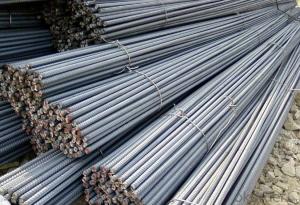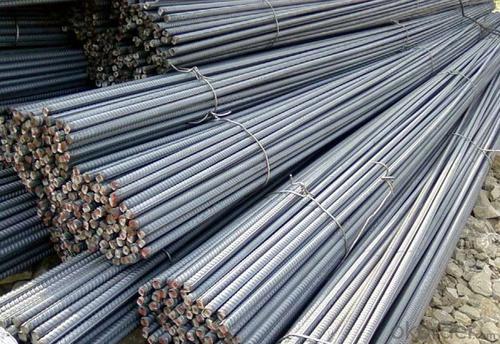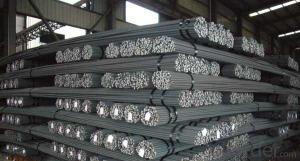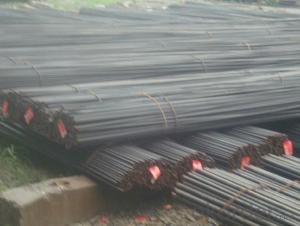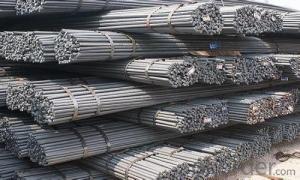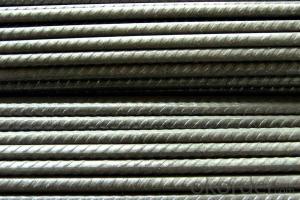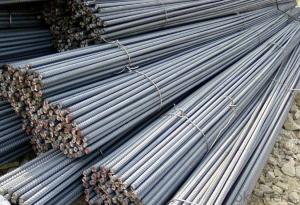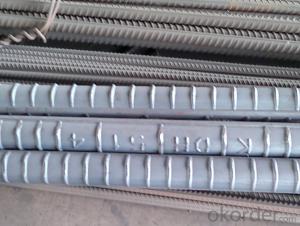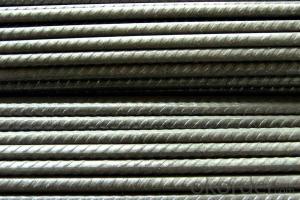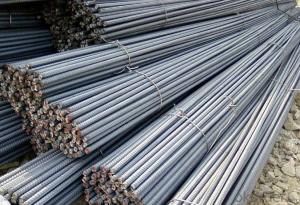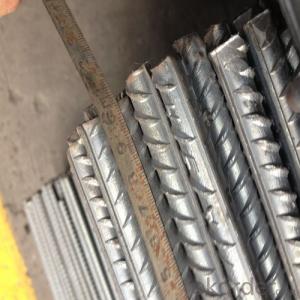Hot rolled deformed bar 6mm-50mm HRB400 ASTM A615
- Loading Port:
- Shanghai
- Payment Terms:
- TT OR LC
- Min Order Qty:
- 25 m.t.
- Supply Capability:
- 20000 m.t./month
OKorder Service Pledge
OKorder Financial Service
You Might Also Like
Deformed Bar Details:
| Minimum Order Quantity: | m.t. | Unit: | m.t. | Loading Port: | |
| Supply Ability: | m.t./month | Payment Terms: | TT OR LC | Package: | wire rod packing |
Product Description:
Product Description:
Specifications of HRB400 Deformed Steel Bar:
Standard | GB | HRB400 | |
Diameter | 6mm,8mm,10mm,12mm,14mm,16mm,18mm,20mm, 22mm,25mm,28mm,32mm,36mm,40mm,50mm | ||
Length | 6M, 9M,12M or as required | ||
Place of origin | Hebei, China mainland | ||
Advantages | exact size, regular package, chemical and mechanical properties are stable. | ||
Type | Hot rolled deformed steel bar | ||
Brand name | DRAGON | ||
Chemical Composition: (Please kindly find our chemistry of our material based on HRB500 as below for your information)
Grade | Technical data of the original chemical composition (%) | ||||||
C | Mn | Si | S | P | V | ||
HRB400 | ≤0.25 | ≤1.60 | ≤0.80 | ≤0.045 | ≤0.045 | 0.04-0.12 | |
Physical capability | |||||||
Yield Strength (N/cm²) | Tensile Strength (N/cm²) | Elongation (%) | |||||
≥400 | ≥570 | ≥14 | |||||
Theoretical weight and section area of each diameter as below for your information:
Diameter(mm) | Section area (mm²) | Mass(kg/m) | Weight of 12m bar(kg) |
6 | 28.27 | 0.222 | 2.664 |
8 | 50.27 | 0.395 | 4.74 |
10 | 78.54 | 0.617 | 7.404 |
12 | 113.1 | 0.888 | 10.656 |
14 | 153.9 | 1.21 | 14.52 |
16 | 201.1 | 1.58 | 18.96 |
18 | 254.5 | 2.00 | 24 |
20 | 314.2 | 2.47 | 29.64 |
22 | 380.1 | 2.98 | 35.76 |
25 | 490.9 | 3.85 | 46.2 |
28 | 615.8 | 4.83 | 57.96 |
32 | 804.2 | 6.31 | 75.72 |
36 | 1018 | 7.99 | 98.88 |
40 | 1257 | 9.87 | 118.44 |
50 | 1964 | 15.42 | 185.04 |
Usage and Applications of HRB400 Deformed Steel Bar:
Deformed bar is widely used in buildings, bridges, roads and other engineering construction. Big to highways, railways, bridges, culverts, tunnels, public facilities such as flood control, dam, small to housing construction, beam, column, wall and the foundation of the plate, deformed bar is an integral structure material. With the development of world economy and the vigorous development of infrastructure construction, real estate, the demand for deformed bar will be larger and larger..
Packaging & Delivery of HRB400 Deformed Steel Bar:
Packaging Detail: products are packed in bundle and then shipped by container or bulk vessel, deformed bar is usually naked strapping delivery, when storing, please pay attention to moisture proof. The performance of rust will produce adverse effect.
Each bundle weight: 2-3MT, or as required
Payment term: TT or L/C
Delivery Detail: within 45 days after received advanced payment or LC.
Label: to be specified by customer, generally, each bundle has 1-2 labels
Trade terms: FOB, CFR, CIF
- Q: Can steel rebars be used in tunnel boring machine (TBM) construction?
- Yes, steel rebars can be used in tunnel boring machine (TBM) construction. Rebars are commonly used in the construction industry to reinforce concrete structures, including tunnels constructed using TBMs. The purpose of using rebars is to provide additional strength and durability to the concrete lining of the tunnel. These rebars are typically placed within the concrete lining during the construction process to enhance its structural integrity and ability to withstand external forces. In TBM construction, the rebars are carefully positioned and secured to ensure proper reinforcement throughout the tunnel. Therefore, steel rebars play a crucial role in the construction of tunnels using TBMs.
- Q: Are steel rebars resistant to fire?
- Yes, steel rebars are highly resistant to fire due to their high melting point and heat conductivity, making them an ideal choice for reinforcing concrete structures in fire-prone areas.
- Q: Are there any standards or codes for steel rebars?
- Yes, there are various standards and codes that govern the manufacturing, testing, and use of steel rebars. These standards typically include specifications for the chemical composition, mechanical properties, dimensions, and tolerances of rebars. Some commonly recognized standards and codes for steel rebars include ASTM A615/A615M, ASTM A706/A706M, and BS 4449. Compliance with these standards ensures the quality and safety of steel rebars used in construction projects.
- Q: How do steel rebars provide reinforcement to concrete?
- Steel rebars provide reinforcement to concrete by adding strength and durability to the structure. When embedded within the concrete, rebars act as tension members, resisting forces that would otherwise cause cracking or failure. The high tensile strength of steel rebars helps to distribute and absorb load, enhancing the overall structural integrity of the concrete.
- Q: How do steel rebars contribute to the strength of concrete?
- Steel rebars contribute to the strength of concrete in several ways. Firstly, they enhance the tensile strength of concrete, which is otherwise relatively low. While concrete is excellent in compression, it is weak when it comes to resisting tension. This is where steel rebars come into play. By embedding them within the concrete, they provide additional strength and help prevent the formation and propagation of cracks. Secondly, steel rebars improve the bond between concrete and the reinforcement material. The ribbed surface of the rebars creates a better grip with the concrete, ensuring a stronger bond. This bond is crucial as it allows the concrete and steel to work together, distributing the loads and minimizing the risk of structural failure. Furthermore, steel rebars increase the overall durability and longevity of concrete structures. They resist corrosion, which is a significant concern in coastal or high humidity areas. The corrosion resistance of rebars ensures that the concrete remains structurally sound for a longer period, reducing maintenance costs and extending the lifespan of the structure. In addition to their strength-enhancing capabilities, steel rebars also contribute to the structural stability of concrete elements. They assist in reinforcing critical areas such as beams, columns, and foundations, where high loads and forces are present. By providing additional support and reinforcement, steel rebars help prevent excessive deflection, bending, or failure of these elements under heavy loads. In summary, steel rebars play a vital role in enhancing the strength of concrete structures by improving tensile strength, bond strength, durability, and overall structural stability. Their incorporation in concrete elements is essential for ensuring the longevity and safety of various construction projects.
- Q: What are the typical costs associated with using steel rebars in a construction project?
- The typical costs associated with using steel rebars in a construction project can vary depending on factors such as the quantity and size of rebars required, market conditions, and location. However, in general, the costs can include the purchase price of the rebars themselves, transportation and delivery expenses, installation labor costs, and any additional fees or taxes. It is advisable to consult with suppliers and contractors to get accurate cost estimates for a specific construction project.
- Q: What is the standard size of a steel rebar?
- The size of a steel rebar can vary depending on the particular application and project requirements. In construction and civil engineering, the standard sizes for steel rebars commonly used are typically 10mm, 12mm, 16mm, 20mm, 25mm, and 32mm in diameter. These sizes are widely accessible and utilized in different structural elements like beams, columns, and slabs. Furthermore, the length of a steel rebar can vary, usually ranging from 6 meters to 12 meters, depending on the project specifications. To determine the appropriate size of steel rebar for a specific construction project, it is crucial to consult the project engineer or refer to the relevant building codes and standards.
- Q: How do steel rebars affect the flexibility of a concrete structure?
- Steel rebars can greatly affect the flexibility of a concrete structure. Rebars, which are essentially steel bars inserted into concrete to provide reinforcement, enhance the structural strength and durability of the concrete. The presence of rebars increases the tensile strength of the concrete, making it more resistant to cracking and bending under external loads. By distributing the load across the entire structure, steel rebars help to prevent localized stress concentrations. This is particularly important in areas such as beams or columns, where large amounts of weight or pressure can be concentrated. The rebars act as a support system, effectively transferring the load to different parts of the structure, ensuring that the concrete can withstand the applied forces without failure. Additionally, steel rebars provide flexibility to the concrete structure by allowing for controlled cracking. Concrete is a brittle material and tends to crack under tensile stress. However, the presence of rebars helps to control and limit the size and extent of cracks that may occur. As the rebars absorb some of the tensile forces, they help to distribute the stress and prevent large cracks from forming. This enhances the overall flexibility of the structure, as controlled cracking allows for slight movements and deformation without compromising the structural integrity. In summary, steel rebars play a crucial role in enhancing the flexibility of a concrete structure. They provide reinforcement and increase the tensile strength of the concrete, preventing cracking and bending under external loads. The rebars also allow for controlled cracking, which helps to distribute stress and maintain the structural integrity of the concrete.
- Q: How are steel rebars protected against chloride attack?
- Steel rebars are protected against chloride attack through various methods such as applying protective coatings, using corrosion inhibitors, ensuring proper concrete cover, and implementing cathodic protection systems. These measures help prevent chloride ions from reaching the rebars, reducing the risk of corrosion and ensuring the structural integrity of the reinforced concrete.
- Q: What are the factors to consider when choosing steel rebars for a project?
- In order to choose steel rebars for a project, there are several important factors that need to be taken into consideration. Firstly, the strength and durability of the rebars are determined by their grade of steel. It is crucial to select a grade that is suitable for the specific project requirements and structural design. Higher grades of steel rebars offer better resistance to corrosion and have higher tensile strength. The size and shape of the rebars should be chosen based on the structural design and load requirements. Different projects may necessitate different diameters and lengths of rebars. The specific dimensions and spacing requirements need to be considered in order to ensure optimal reinforcement. Depending on the project's location and exposure to environmental conditions, it is essential to select rebars with appropriate corrosion resistance. This can be achieved by using rebars with protective coatings, such as epoxy or galvanized coatings, or by opting for stainless steel rebars. If welding is required for the project, it is important to take into account the rebars' weldability. Some rebars may require special procedures or preheating before welding, while others may not be suitable for welding at all. The cost of steel rebars can vary based on grade, size, and other factors. It is important to find a balance between the project's budget and the required quality and strength of the rebars. Additionally, considering the rebars' lifecycle cost, including maintenance and potential repairs, can help make a more economical choice. The availability of the required rebars in the local market should also be considered. It is important to ensure that the desired grade, size, and quantity of rebars are readily available in order to avoid delays in the project. Steel rebars should meet the relevant national or international standards, such as ASTM or BS, in order to ensure their quality and performance. Compliance with these standards guarantees that the rebars have been manufactured and tested to meet specific requirements. Seeking expert advice from structural engineers or experts in steel reinforcement can provide valuable insights and recommendations. They can assess the project's needs and offer guidance on the most suitable rebars for the specific application. By taking into account these factors, the selection of appropriate steel rebars that meet the project's requirements in terms of strength, durability, corrosion resistance, and cost-effectiveness can be ensured.
Send your message to us
Hot rolled deformed bar 6mm-50mm HRB400 ASTM A615
- Loading Port:
- Shanghai
- Payment Terms:
- TT OR LC
- Min Order Qty:
- 25 m.t.
- Supply Capability:
- 20000 m.t./month
OKorder Service Pledge
OKorder Financial Service
Similar products
Hot products
Hot Searches
Related keywords
